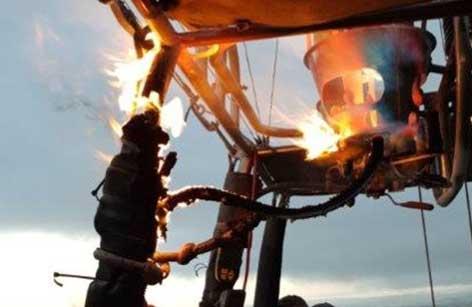A hot air balloon in-flight fire demonstrates the importance of pilots preparing for the possibility of fire, including rehearsing emergency procedures and wearing appropriate protective clothing, a new ATSB investigation highlights.

The 26 December 2018 scenic flight had departed Wandin, Victoria, with a pilot and 15 passengers on board.
Twenty minutes into the flight, while at an altitude of about 800 ft, the pilot heard a small explosion from the front left burner and then observed a small fire had started on the outside of the burner. Despite attempts to extinguish the fire, it re-ignited twice and the pilot’s compartment caught fire.
About eight minutes after the fire first ignited, the pilot identified a suitable landing position. During the decent, the basket struck some treetops and ropes became tangled in the branches. The branches whipped around and into the basket, and one passenger sustained cuts to his hand.
As the basket touched the ground, the passengers on the right-hand side of the basket jumped out, causing the right side of the basket to lift off the ground again. In response, the pilot quickly pulled the red line to evacuate the hot air from the envelope and brought the basket back down to the ground. The remaining passengers then jumped out and ran to safety.
The fire continued to burn as the pilot secured the balloon. When emergency services arrived on site, flames had engulfed the balloon. By the time firefighters extinguished the flames, the fire had destroyed the balloon.
In the event of an in-flight balloon fire, the first priority must be the isolation of the fuel supply at the fuel tank.
The ATSB investigation found that a fuel leak at the front left burner has resulted in the fire. After the fire broke out, the hand-wheel valve on the liquid outlet of the fuel tank and the pilot burners were not shut off, which resulted in the pilot being unable to control the fire.
“Pilots experience a high workload during in-flight emergencies. However, in the event of an in‑flight balloon fire, the first priority must be isolation of the fuel supply at the fuel tank,” said ATSB Executive Director Transport Safety Mr Nat Nagy.
“In addition, it is good practice to rehearse emergency procedures by standing in the basket to run through the checklist steps.”
Mr Nagy noted that further ways to reduce risk to individuals and improve survivability outcomes include wearing appropriate protective clothing, including cotton long‑sleeved shirts and trousers, leather gloves, and enclosed footwear.
“Operators should also consider utilising componentry that provides a visual indication of the system status, for example, 90‑degree valves on liquid outlets.”
Read the report: In-flight fire involving Kavanagh B-350 hot air balloon, VH-ZYO, near Coldstream, Victoria, on 26 December 2018


